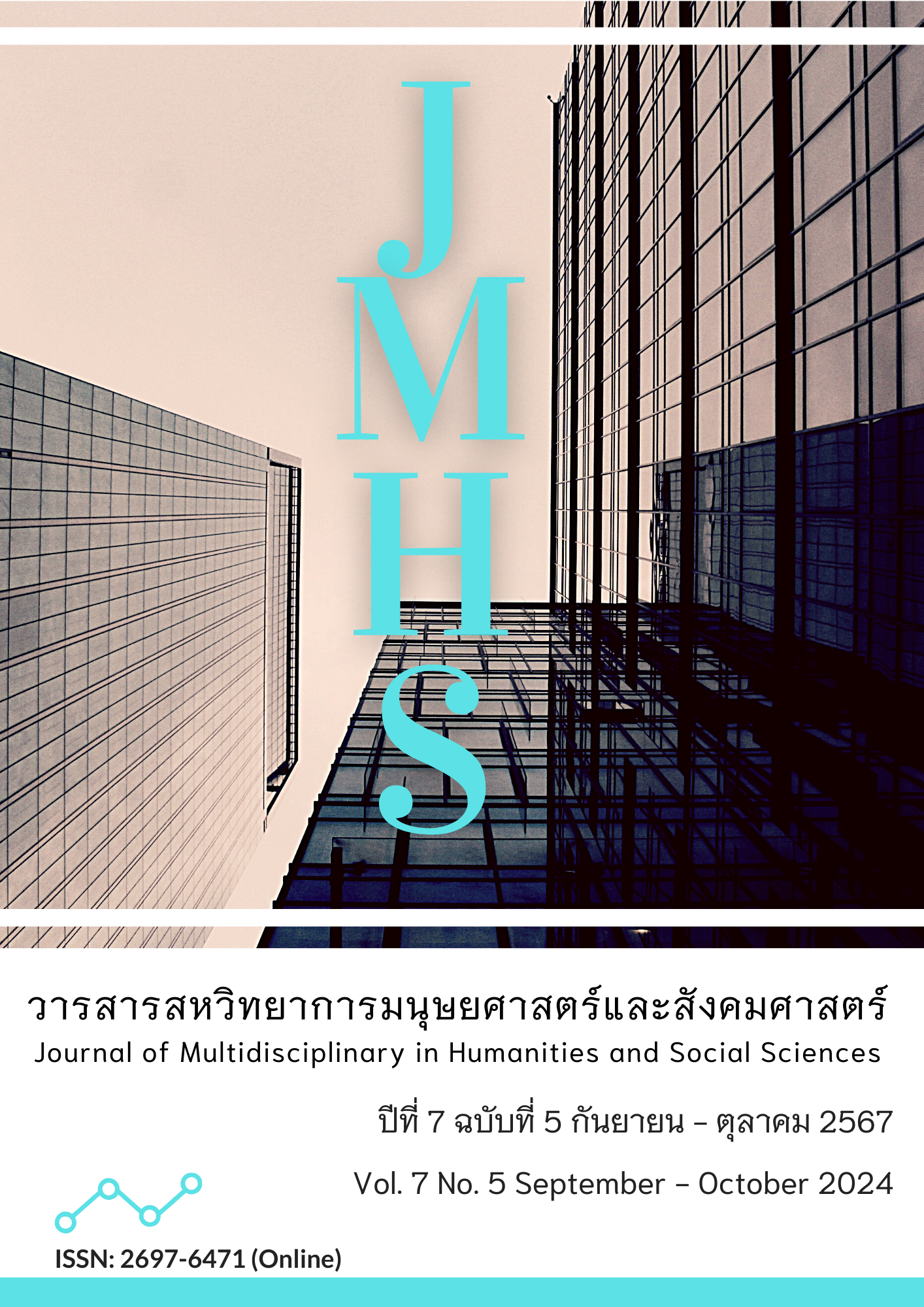โมเดลความสัมพันธ์เชิงสาเหตุของปัจจัยการบริหารคนเก่งที่ส่งผลต่อผลการดำเนินงานธุรกิจก่อสร้างในประเทศไทย
Main Article Content
บทคัดย่อ
บทความนี้มีวัตถุประสงค์เพื่อพัฒนาโมเดลความสัมพันธ์เชิงสาเหตุของปัจจัยการบริหารคนเก่งที่ส่งผลต่อผลการดำเนินงานของธุรกิจก่อสร้างในประเทศไทย เป็นการวิจัยแบบผสมผสานโดยเริ่มจากการวิจัยเชิงปริมาณแล้วจึงตามด้วยการวิจัยเชิงคุณภาพ กลุ่มตัวอย่าง คือ ผู้ประกอบการ ผู้บริหาร และพนักงานของธุรกิจก่อสร้างในประเทศไทย จำนวน 425 คน โดยสุ่มตัวอย่างแบบหลายขั้นตอน และทำการสัมภาษณ์เชิงลึกกับผู้ให้ข้อมูลสำคัญ คือ ผู้บริหารระดับสูง นักบริหารด้านทรัพยากรมนุษย์ และผู้เชี่ยวชาญด้านธุรกิจก่อสร้าง จำนวน 12 คน โดยสุ่มตัวอย่างแบบเจาะจง เครื่องมือที่ใช้ในการวิจัย คือ 1) แบบสอบถามออนไลน์ และ 2) แบบสัมภาษณ์แบบกึ่งโครงสร้าง วิเคราะห์ข้อมูลโดยใช้สถิติเชิงพรรณนา สถิติเชิงอนุมาน และการวิเคราะห์เนื้อหา
ผลการวิจัยพบว่า โมเดลความสัมพันธ์เชิงสาเหตุของปัจจัยการบริหารคนเก่งที่ส่งผลต่อผลการดำเนินงานของธุรกิจก่อสร้างในประเทศไทยที่พัฒนาขึ้น ประกอบด้วย 4 องค์ประกอบ ได้แก่ ปัจจัยระบบบริหารคนเก่ง ปัจจัยสภาพแวดล้อมภายใน ปัจจัยสภาพแวดล้อมภายนอก และผลการดำเนินงานของธุรกิจ สอดคล้องกับข้อมูลเชิงประจักษ์ โดยโมเดลสามารถอธิบายความแปรปรวนของปัจจัยการบริหารคนเก่งส่งผลต่อผลการดำเนินงานของธุรกิจก่อสร้างในประเทศไทยได้ร้อยละ 77 นอกจากนี้ ผลการวิจัยเชิงคุณภาพได้ค้นพบองค์ประกอบเพิ่มเติมในปัจจัยสภาพแวดล้อมภายใน คือ วัฒนธรรมองค์การ องค์ความรู้จากงานวิจัยนี้ สามารถนำไปใช้ในการวางแผนกลยุทธ์ในการส่งเสริมและพัฒนาเพื่อเพิ่มศักยภาพในการแข่งขันของธุรกิจก่อสร้างในประเทศไทย
Article Details

อนุญาตภายใต้เงื่อนไข Creative Commons Attribution-NonCommercial-NoDerivatives 4.0 International License.
ทัศนะและความคิดเห็นที่ปรากฏในวารสาร ถือเป็นความรับผิดชอบของผู้เขียนบทความนั้น และไม่ถือเป็นทัศนะและความรับผิดชอบของกองบรรณาธิการ
เอกสารอ้างอิง
นภดล ร่มโพธิ์. (2553). การวัดผลองค์กรแบบสมดุล. กรุงเทพฯ: คณะบุคคลอิเมจิเนียริ่ง.
นิสดารก์ เวชยานนท์. (2563). ความสัมพันธ์ของระบบบริหารคนเก่งภาครัฐกับผลการปฏิบัติงาน: ศึกษากรณี ระบบผู้มีผลสัมฤทธิ์สูง (HiPPS) ของสำนักงาน ก.พ. วารสารการจัดการภาครัฐและภาคเอกชน, 27(1), 111-140.
วิจัยกรุงศรี. (2565). แนวโน้มธุรกิจ/อุตสาหกรรม ปี 2565-2567: ธุรกิจรับเหมาก่อสร้าง. สืบค้นจาก https://www.krungsri.com/th/research/industry/industry-outlook/construction-construction-materials/construction-contractors/io/construction-contractor-2022
สำนักงานคณะกรรมการพัฒนาเศรษฐกิจและสังคมแห่งชาติ. (2565). สรุปสาระสำคัญแผนพัฒนาเศรษฐกิจและสังคมแห่งชาติ ฉบับที่ 12 (2560-2564 และ 2565). สืบค้นจาก https://www.nesdc.go.th/ewt_dl_link.php?nid=6422
สุกัญญา รัศมีธรรมโชติ. (2554). พัฒนาดาวเด่นเพื่อองค์กรที่เป็นเลิศด้วย Talent Management by Competency-Based Career Development and Succession Planning. กรุงเทพฯ: พริ้นท์ซิตี้.
อาภรณ์ ภู่วิทยพันธุ์. (2550). กลยุทธ์การบริหารและพัฒนาพนักงานดาวเด่น. กรุงเทพฯ: เอชอาร์ เซ็นเตอร์.
Asean-info.com. (2013). 2024 Global threat report. Retrieved August 2, 2016, from http://www.asean-info.com/asean_ members/thailand_economics.html.
Collings, D.G., & Mellahi, K. (2009). Strategic talent management: A review and research agenda.
Human Resource Management Review, 19(4), 304–313. https://doi.org/10.1016/j.hrmr.2009.04.001
Collings, D.G., Mellahi, K., & Cascio, W.F. (2019). Global talent management and performance in multinational enterprises: A multilevel perspective. Journal of Management, 45(2), 540-566. https://doi.org/10.1177/0149206318757018
Georgiev, M. (2017). The role of the balanced scorecard as a tool of strategic management and control. Journal of Innovations and Sustainability, 3(2), 31-63. https://doi.org/10.51599/is.2017.03.02.31
Gomes, J., & Romão, M. (2017). The balanced scorecard: Keeping updated and aligned with today’s business trends. International Journal of Productivity Management and Assessment Technologies, 5(2), 1-15. https://doi.org/10.4018/IJPMAT.2017070101
Gubman, E.L. (1998). The Talent Solution: Aligning Strategy and People to Achieve Extraordinary Results. New York: McGraw-Hill.
Hair, J.F., Risher, J.J., Sarstedt, M., & Ringle, C.M. (2019). When to use and how to report the results of PLS-SEM. European Business Review, 31(1), 2-24. https://doi.org/10.1108/EBR-11-2018-0203
Hongal, P., & Kinange, U. (2020). A study on talent management and its impact on organization performance - An empirical review. International Journal of Engineering and Management Research, 10(1), 64-71. https://doi.org/10.31033/ijemr.10.1.12
Hristov, I., Chirico, A., & Appolloni, A. (2019). Sustainability value creation, survival, and growth of the company: A critical perspective in the sustainability balanced scorecard (SBSC). Sustainability, 11(7), 2119. https://doi.org/10.3390/su11072119
Genc, K.Y. (2014). Environmental factors affecting human resources management activities of Turkish Large Firms. International Journal of Business and Management, 9(11), 102-122. http://dx.doi.org/10.5539/ijbm.v9n11p102
Kaplan, R.S., & Norton, D.P. (1992). The balanced scorecard: measures that drive performance. Harvard Business Review, 70(1), 71-79.
Miles, M.B., Huberman, M., & Saldana, J. (2020). Qualitative Data Analysis: A Methods Sourcebook. (4th ed.). Thousand Oaks: SAGE Publication.
Osewe, J.O. (2022). Institutional rationale for balanced scorecard adoption and performance of Kenya’s state corporations. European Journal of Humanities and Social Sciences, 2(3), 95-101. https://doi.org/10.24018/ejsocial.2022.2.3.86
Schumacker, R.E., & Lomax, R.G. (2010). A Beginner's Guide to Structural Equation Modeling. (3rd ed.). New York: Routledge Taylor & Francis Group.
Shikweni, S., Schurink, W., & Wyk, R.V. (2019). Talent management in the South African construction industry. SA Journal of Human Resource Management, 17(1), 1-12. https://doi.org/10.4102/sajhrm.v17i0.1094


